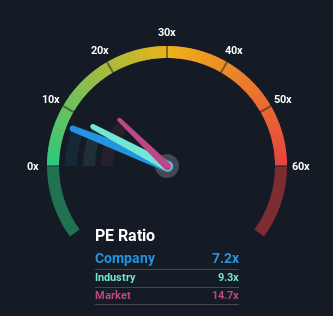- United States
- /
- Specialty Stores
- /
- NYSE:VSCO
Little Excitement Around Victoria's Secret & Co.'s (NYSE:VSCO) Earnings As Shares Take 26% Pounding

The Victoria's Secret & Co. (NYSE:VSCO) share price has fared very poorly over the last month, falling by a substantial 26%. Instead of being rewarded, shareholders who have already held through the last twelve months are now sitting on a 40% share price drop.
Following the heavy fall in price, Victoria's Secret may be sending very bullish signals at the moment with its price-to-earnings (or "P/E") ratio of 7.2x, since almost half of all companies in the United States have P/E ratios greater than 15x and even P/E's higher than 30x are not unusual. Nonetheless, we'd need to dig a little deeper to determine if there is a rational basis for the highly reduced P/E.
Victoria's Secret hasn't been tracking well recently as its declining earnings compare poorly to other companies, which have seen some growth on average. It seems that many are expecting the dour earnings performance to persist, which has repressed the P/E. If you still like the company, you'd be hoping this isn't the case so that you could potentially pick up some stock while it's out of favour.
See our latest analysis for Victoria's Secret

Is There Any Growth For Victoria's Secret?
The only time you'd be truly comfortable seeing a P/E as depressed as Victoria's Secret's is when the company's growth is on track to lag the market decidedly.
Retrospectively, the last year delivered a frustrating 44% decrease to the company's bottom line. This has erased any of its gains during the last three years, with practically no change in EPS being achieved in total. Accordingly, shareholders probably wouldn't have been overly satisfied with the unstable medium-term growth rates.
Shifting to the future, estimates from the ten analysts covering the company suggest earnings should grow by 1.7% each year over the next three years. That's shaping up to be materially lower than the 9.6% each year growth forecast for the broader market.
With this information, we can see why Victoria's Secret is trading at a P/E lower than the market. It seems most investors are expecting to see limited future growth and are only willing to pay a reduced amount for the stock.
The Final Word
Having almost fallen off a cliff, Victoria's Secret's share price has pulled its P/E way down as well. It's argued the price-to-earnings ratio is an inferior measure of value within certain industries, but it can be a powerful business sentiment indicator.
We've established that Victoria's Secret maintains its low P/E on the weakness of its forecast growth being lower than the wider market, as expected. At this stage investors feel the potential for an improvement in earnings isn't great enough to justify a higher P/E ratio. It's hard to see the share price rising strongly in the near future under these circumstances.
Before you take the next step, you should know about the 2 warning signs for Victoria's Secret (1 is potentially serious!) that we have uncovered.
If P/E ratios interest you, you may wish to see this free collection of other companies that have grown earnings strongly and trade on P/E's below 20x.
If you're looking to trade Victoria's Secret, open an account with the lowest-cost platform trusted by professionals, Interactive Brokers.
With clients in over 200 countries and territories, and access to 160 markets, IBKR lets you trade stocks, options, futures, forex, bonds and funds from a single integrated account.
Enjoy no hidden fees, no account minimums, and FX conversion rates as low as 0.03%, far better than what most brokers offer.
Sponsored ContentNew: Manage All Your Stock Portfolios in One Place
We've created the ultimate portfolio companion for stock investors, and it's free.
• Connect an unlimited number of Portfolios and see your total in one currency
• Be alerted to new Warning Signs or Risks via email or mobile
• Track the Fair Value of your stocks
Have feedback on this article? Concerned about the content? Get in touch with us directly. Alternatively, email editorial-team (at) simplywallst.com.
This article by Simply Wall St is general in nature. We provide commentary based on historical data and analyst forecasts only using an unbiased methodology and our articles are not intended to be financial advice. It does not constitute a recommendation to buy or sell any stock, and does not take account of your objectives, or your financial situation. We aim to bring you long-term focused analysis driven by fundamental data. Note that our analysis may not factor in the latest price-sensitive company announcements or qualitative material. Simply Wall St has no position in any stocks mentioned.
About NYSE:VSCO
Victoria's Secret
Operates as a specialty retailer of women’s intimate, and other apparel and beauty products worldwide.
Solid track record and good value.
Similar Companies
Market Insights
Community Narratives


